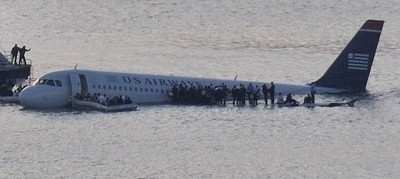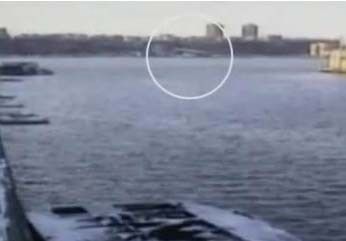 The FAA has made a
statement today before a House Committee that seems, at best, to be
looking to gain a few more headlines in the wake of the successful
USAir ditching in the Hudson River last month. The FAA sent its new
FAA Admin For Aviation Safety, Peggy Gilligan, a career FAA
bureaucrat with an interesting history of industry 'run-ins', who
has replaced the recently retired (and highly respected) Nick
Sabatini. Basking in the glow of the successful rescue of all
aboard, the FAA took the time to recite a number of issues with the
current dilemma over bird-strikes and gave the testimony attached
below...
The FAA has made a
statement today before a House Committee that seems, at best, to be
looking to gain a few more headlines in the wake of the successful
USAir ditching in the Hudson River last month. The FAA sent its new
FAA Admin For Aviation Safety, Peggy Gilligan, a career FAA
bureaucrat with an interesting history of industry 'run-ins', who
has replaced the recently retired (and highly respected) Nick
Sabatini. Basking in the glow of the successful rescue of all
aboard, the FAA took the time to recite a number of issues with the
current dilemma over bird-strikes and gave the testimony attached
below...
Statement of Peggy Gilligan, Deputy Associate Administrator for
Aviation Safety
Before the U.S. House of Representatives, Committee on
Transportation and Infrastructure, Subcommittee on Aviation on US
Airways Flight 1549
Chairman Costello, Ranking Member Petri, Members of the
Subcommittee:
Thank you for inviting the Federal Aviation Administration (FAA)
here today to discuss the events surrounding the US Airways Flight
1549 emergency landing in the Hudson River on January 15, 2009. My
name is Peggy Gilligan and I am the new Associate Administrator for
Aviation Safety at the FAA.
This was a truly extraordinary event in aviation history: a
multiple bird ingestion that virtually simultaneously caused engine
failure in both engines of a commercial airliner on takeoff,
resulting in an emergency water landing with no loss of life. While
the FAA does have aircraft standards and crew training and
procedures in place to address these issues, the circumstances of
US Airways Flight 1549 were simply unprecedented, and we, just as
the rest of the world, are awed by the quick thinking and
consummate professionalism of the entire crew of Flight 1549.
Because the National Transportation Safety Board (NTSB) is still
investigating the matter, my testimony today will primarily address
the FAA’s efforts in three areas: first, how the FAA works
with airports to reduce the probability of bird strikes; second,
what the FAA standards are for aircraft to increase survivability
in crashes; and third, what the FAA requires in terms of flight
crew training when encountering emergency situations such as this.
I also want to note the role played by FAA air traffic controllers
and flight managers whenever an aircraft emergency develops,
whether due, as here, to bird strikes, or some other cause.
Bird Strike Mitigation
 Since 1990, the FAA
has collected over 100,000 voluntary wildlife strike reports and
has maintained a bird strike database. The Wildlife Services
Program of the U.S. Department of Agriculture (USDA) manages the
database under terms of an interagency agreement with FAA. Strike
reports are sent to Wildlife Services where they are edited and
entered into the database. Embry-Riddle University maintains the
public FAA website for bird strike data.
Since 1990, the FAA
has collected over 100,000 voluntary wildlife strike reports and
has maintained a bird strike database. The Wildlife Services
Program of the U.S. Department of Agriculture (USDA) manages the
database under terms of an interagency agreement with FAA. Strike
reports are sent to Wildlife Services where they are edited and
entered into the database. Embry-Riddle University maintains the
public FAA website for bird strike data.
Currently, the database has 106,604 records from January 1990
through August 2008. The increasing number of bird strikes is a
combination of better reporting and increasing bird populations.
The database is available to airport operators and safety analysts
and is extremely useful for determining which species are most
frequently involved in strikes, seasonal patterns, and extent and
type of damage from strikes.
Mandatory reporting of wildlife strikes is extremely difficult
to enforce and may not necessarily increase accurate reporting. The
success of the voluntary reporting system is proven by the increase
in annual reports from only 1,900 reported strikes in 1990, to
almost 8,000 reported strikes in 2007. Advances in wildlife strike
reporting through web-based technology make it easier and faster to
report strikes. Moreover, the FAA, in close partnership with the
USDA, continues to educate and increase awareness through ongoing
campaigns in concert with industry, conferences and participation
on the national Bird Strike Committee.
The FAA has an interagency agreement with the Smithsonian
Institution to analyze bird remains at the Feather Identification
Laboratory (National Museum of Natural History) to determine
species identifications. In 2003, the FAA purchased a DNA sequencer
to assist in building a DNA library and improve the identification
capability of the laboratory. Airports can mail small remains from
bird strikes to the feather laboratory at the Smithsonian. The
laboratory then analyzes the remains and provides the species
information to the airport and the FAA Wildlife Strike Database.
Species information is vital for the airports and wildlife managers
when considering appropriate mitigation measures. Additionally,
engineers use the data provided on species weights to test new
engine designs. The Feather Identification Lab identified over 700
cases for the FAA in 2008.
Our statistics on bird strikes indicate that the closer the
aircraft is to the runway, the higher the risk of a bird strike.
Conversely, the risk of a substantial bird strike decreases
significantly with altitude. High altitude strikes are not common,
though they do occur. For instance, at 30,000 feet, there was only
one reported bird strike, between 1990-2008. However, about 73% of
all strikes occur within the airport environment up to 500 feet
above ground. According to reports, Flight 1549 had reached an
altitude of 3,200 feet when it encountered a flock of Canada geese
that resulted in numerous bird strikes to the airframe and
engines.
Since the data indicate that the greatest risk of bird strikes
occurs at the airport, the FAA has focused its bird strike
mitigation efforts at airports. By regulation, the FAA requires
commercial service airports to maintain a safe operation. This
includes conducting Wildlife Hazard Assessments and preparing a
Wildlife Hazard Management Plan, if necessary.
Wildlife Assessment
 As noted, a Wildlife
Assessment is required of all commercial airports and requires
consideration of wildlife attractants within 10,000 feet of an
airport. FAA also recommends consideration of wildlife attractants
(food, water, and habitat) within five miles of the airport, if the
attractant could cause hazardous wildlife movement into or across
the approach or departure airspace. The assessment considers:
As noted, a Wildlife
Assessment is required of all commercial airports and requires
consideration of wildlife attractants within 10,000 feet of an
airport. FAA also recommends consideration of wildlife attractants
(food, water, and habitat) within five miles of the airport, if the
attractant could cause hazardous wildlife movement into or across
the approach or departure airspace. The assessment considers:
- An analysis of events prompting the assessment
- Identification of wildlife species observed and their numbers,
locations, and local movements
- Identification of features on or near the airport that attract
wildlife
- A description of the wildlife hazards to air carrier
operations
- Recommended actions for reducing wildlife hazards to air
carrier operations
- The Wildlife Assessment is submitted to the FAA. The agency
then determines if the airport needs to develop a Wildlife Hazard
Mitigation Plan.
Wildlife Hazard Mitigation Plan
Such a plan would:
- Provide measures to alleviate or eliminate wildlife
hazards
- Identify persons who have authority for implementing the
plan
- Identify priorities for needed habitat modification
- Identify resources for the plan
- Establish procedures to be followed during air carrier
operations
- Outline wildlife control measures
- Typical wildlife mitigation techniques include habitat
modification, including filling in ponds and water sources, if
practicable, and controlling vegetation, e.g., cutting grass high
or low depending upon bird species. Airports may also use wildlife
harassment tools, such as air guns, lasers, dogs, wildlife patrols,
trapping and removing the wildlife, and as a last resort,
exterminating the wildlife with the appropriate permits. Ongoing
research into wildlife mitigation techniques continues to be
explored by the USDA Wildlife Services program through an
interagency agreement with the FAA.
Bird Radar Research
Additionally, in 2000, the FAA began research to determine
if low cost radars can reliably detect birds at or near (within
three to possibly five miles of) airports and be used to develop an
airport bird strike advisory system. These systems generally work
by overlaying the radar data on an airport geographic information
system.
Bird detection radar may have the most promise as tools to help
airport operators manage their wildlife control programs. However,
as many airports routinely have birds in the area, we do not yet
know if this system would be capable of providing alerts that would
be operationally suitable for making specific time-critical
decisions on landing or takeoff.
The research is continuing to address these operational type
issues. We are conducting radar evaluations currently with two Bird
Radar systems at Seattle-Tacoma International Airport, two Bird
Radar systems at Naval Air Station Whidbey Island in Oak Harbor,
WA, and one portable research radar unit that is owned/leased by
the University of Illinois, currently finishing a brief deployment
at YVR (Vancouver, British Columbia, Canada). We are planning
additional testing at Chicago O’Hare, Dallas-Ft. Worth, and
John F. Kennedy International Airports, starting later this year.
The FAA plans to collaborate with the USDA Wildlife Services
program during these additional radar testing phases to determine
operational suitability of this technology at airports.
Aircraft Certification and
“Survivability”
 In addition to our
bird strike mitigation efforts, the FAA certifies all civil
aircraft to meet a series of minimum standards. To receive FAA
approval, an aircraft must be airworthy – that is, be
designed and built to fly safely — as well as survive
situations in which internal or external factors may interfere with
safe operations of the aircraft. When the FAA certificated the
Airbus A320, the design requirements and operating procedures took
into account numerous exigencies, including: flight into a flock of
birds, emergency landings on land, loss of engine power, and
emergency landings in water.
In addition to our
bird strike mitigation efforts, the FAA certifies all civil
aircraft to meet a series of minimum standards. To receive FAA
approval, an aircraft must be airworthy – that is, be
designed and built to fly safely — as well as survive
situations in which internal or external factors may interfere with
safe operations of the aircraft. When the FAA certificated the
Airbus A320, the design requirements and operating procedures took
into account numerous exigencies, including: flight into a flock of
birds, emergency landings on land, loss of engine power, and
emergency landings in water.
Engine Bird Ingestion
The A320 involved in Flight 1549 was powered by two
CFM56-5B4/P engines, which were certified to meet these
requirements:
Flocking Birds — the engine was able to ingest a flock of
birds (seven 1.5 lb. birds), not lose more than ¼ of its
power and continue to run for five minutes at its takeoff power
setting.
Single Bird — the engine was able to ingest a single large
bird (4 lbs.) and be able to shut down safely. When a large bird is
ingested, no continued operation is required – essentially,
the engine is designed to shut down, e.g., with no hazardous debris
or fire.
Airplane Flotation
Even though landing in water is an extremely rare occurrence, all
transport category airplanes must float long enough to permit all
the occupants to escape. In addition, the A320 was certified for
“ditching” — that is, a prepared emergency
landing in water, meeting the following requirements:
- The airplane must float in such a way that there are sufficient
exits above water.
- The plane must be able to land in water and float under
reasonable conditions long enough to allow evacuation of passengers
into life rafts.
- Structural damage that might occur as a result of landing in
water must be considered when determining the flotation
characteristics.
- The airplane must carry special equipment, such as rafts, life
vests and survival kits.
- Certification for ditching occurs when an airplane is intended
to be operated extensively on routes that are over water.
Seats
The seats on this airplane were designed to withstand 9 times the
force of gravity, as are the overhead stowage compartments and
other interior features. There are later standards that require
dynamic testing of seats up to 16 times the force of gravity
— commonly known as “16g seats;” however, these
standards are not applicable to the A320.
What occurred to Flight 1549 indicates that all these standards
were met. Current evidence points to engine bird ingestion of
multiple Canada geese weighing on average between 6-10 lbs. each,
far beyond the parameters of the birds for which the engine was
designed to handle. Nonetheless, the engines reacted exactly as was
intended; after the birds were ingested, they remained intact and
did not shed any parts that might have damaged the aircraft
fuselage; and they remained on the wing — allowing the crew
to maintain flight.
Preliminary evidence indicates that the seats and all the
interior structure performed very well in this accident, with
minimal injuries to passengers as a direct result of the crash.
Moreover, the aircraft did float — exits remained available
and there was sufficient time for the successful evacuation of
everyone on board.
Crew Training
In addition to our requirements for aircraft
certification, Federal Aviation Regulations require all airlines to
develop specific ditching procedures appropriate to their
operations. Many airlines, including US Airways, tailor their
training to their specific operations, with emphasis on areas of
high risk. Airlines must submit these curricula to the FAA for
review and approval before conducting any flight operations. Even
though an airline may not spend extensive portions of its
operations over water, it still has to have basic ditching training
for its flight and cabin crews. Actual ditching training differs
from airline to airline, based on the amount of their overwater
operations.

The training is scenario based, meaning it includes a detailed
dissection of an actual accident or incident and how the incident
can be handled successfully. The crew is trained on all emergency
procedures developed by the manufacturer, and this includes
ditching. Training on handling emergencies — crew resource
management, decision making, workload management, crisis response,
and situational awareness — would be applicable to ditching
through skill transfer, and that can be checked in a simulator.
This scenario-based training and checking allows airlines to focus
on events that are more likely to happen in actual, real-world
operations.
Required ditching training includes emergency training with
respect to each airplane type, model, and configuration for each
required crewmember and each kind of operation that the airline
proposes. All airline crewmembers must receive ditching training
during their initial training and at recurrent intervals consistent
with the airline’s approved training program.
US Airways flight attendants receive initial and recurrent
training in ditching procedures, including:
- Cabin preparations
- Raft drills
- Passenger preparations
- Evacuations
- US Airways pilots receive ditching training at their initial
indoctrination with the airline using a case study of a 1970
ditching by a DC-9, then later receive A320-specific instruction
during recurrent training.
Areas covered include:
- Aircraft “clean-up” (configuration for
ditching)
- Communications with air traffic control and cabin
crewmembers
- Crew resource management
- Ditching direction, based on wind or calm, swell direction
- Post-ditching procedures, e.g., signaling, survival,
first-aid
- The ditching procedures are broken into segments above 10,000
feet and below 10,000 feet. Crewmembers are trained on both
procedures. The above-10,000 feet procedures are focused on
troubleshooting and engine restart. The below-10,000 feet
procedures focus on “cleaning up” the aircraft,
preparing the cabin crew for a water evacuation, setting all the
equipment and switches for ditching, and communicating with air
traffic control. The crew is trained to use the applicable
procedure.
Flight 1549
While the FAA has been working for decades on bird strike
mitigation, improving aircraft to increase passenger survivability,
and training pilots and crew for emergencies, none of that should
take away from the extraordinary acts of this incredible crew. From
Captain Chesley Sullenberger’s strong background as a pilot
and safety expert, which enabled him to control the aircraft so
skillfully, to First Officer Jeffrey Skiles’ efforts to
restart the engines and initiate the emergency landing checklist,
to the incredible professionalism of the flight attendants, Donna
Dent, Doreen Welsh, and Sheila Dail, in instructing and guiding the
passengers to safety, there will probably be no more storied,
heroic aviation crew in history. The fact remains that for all the
training and technological advances we might make, the human
element is where it can all fail, or where it can astonish us
all.

Every aviator from the onset of his or her aviation training is
taught these priorities in order: “aviate, navigate,
communicate” — to fly the airplane, first and foremost;
to navigate to a suitable emergency landing area; and to
communicate with air traffic control the nature of the emergency so
rescue can occur. Captain Sullenberger and his crew responded
admirably to their training and their instincts and aviated,
navigated, and communicated to a successful conclusion.
At this juncture, I want to make sure that I point out the
equally admirable work of, Patrick Harten, the air traffic
controller who communicated with Captain Sullenberger during those
harrowing moments. From clearing airspace and runways for an
emergency landing, to calling upon other aircraft to be additional
eyes, to alerting his colleagues of the impending emergency, Mr.
Harten was without doubt a crucial part of this incredible story. I
also want to commend Michael Guarnieri, the air traffic controller
at Teterboro, who instantly made a runway available at that airport
in the event Flight 1549 was able to land there, and Robert Schmid,
also at Teterboro, who did a great job of coordinating the
emergency response notifications.
Our controllers are trained to respond to intense and stressful
situations, as a matter of course. They have to be able to gather
information from multiple sources, have constant situational
awareness, and make instantaneous decisions. Every part of their
training is designed to enhance each of these skills. It does not
at all surprise the FAA that these controllers were so calm and
professional in what was undoubtedly an incredibly pressurized
situation, but once again, we are impressed with the high level of
skill that these gentlemen displayed.
The incredible timeliness and efforts of the personnel on the
commercial water vessels and other first responders who helped
rescue the passengers and crew of Flight 1549 from the Hudson River
that day was also extraordinary. From the ferries and tug boat
crews to the New York City Fire and Police Departments, the
combined efforts and quick thinking of all involved in getting the
passengers and crew safely to shore were amazing and moving to
see.

Finally, I must note that as we celebrate the outcome of Flight
1549, we also mourn the tragic loss of life on Colgan Air 3407 in
Buffalo, New York. I know that the Members of this Committee will
want to discuss this as soon as possible. We are fully supportive
of the ongoing NTSB investigation in that case and I want to assure
you that we will always strive to provide you with the timeliest
information possible.
 Classic Aero-TV: The Switchblade Flying Car FLIES!
Classic Aero-TV: The Switchblade Flying Car FLIES! ANN FAQ: Q&A 101
ANN FAQ: Q&A 101 ANN's Daily Aero-Term (04.12.24): Discrete Code
ANN's Daily Aero-Term (04.12.24): Discrete Code ANN's Daily Aero-Term (04.13.24): Beyond Visual Line Of Sight (BVLOS)
ANN's Daily Aero-Term (04.13.24): Beyond Visual Line Of Sight (BVLOS) ANN's Daily Aero-Linx (04.13.24)
ANN's Daily Aero-Linx (04.13.24)









